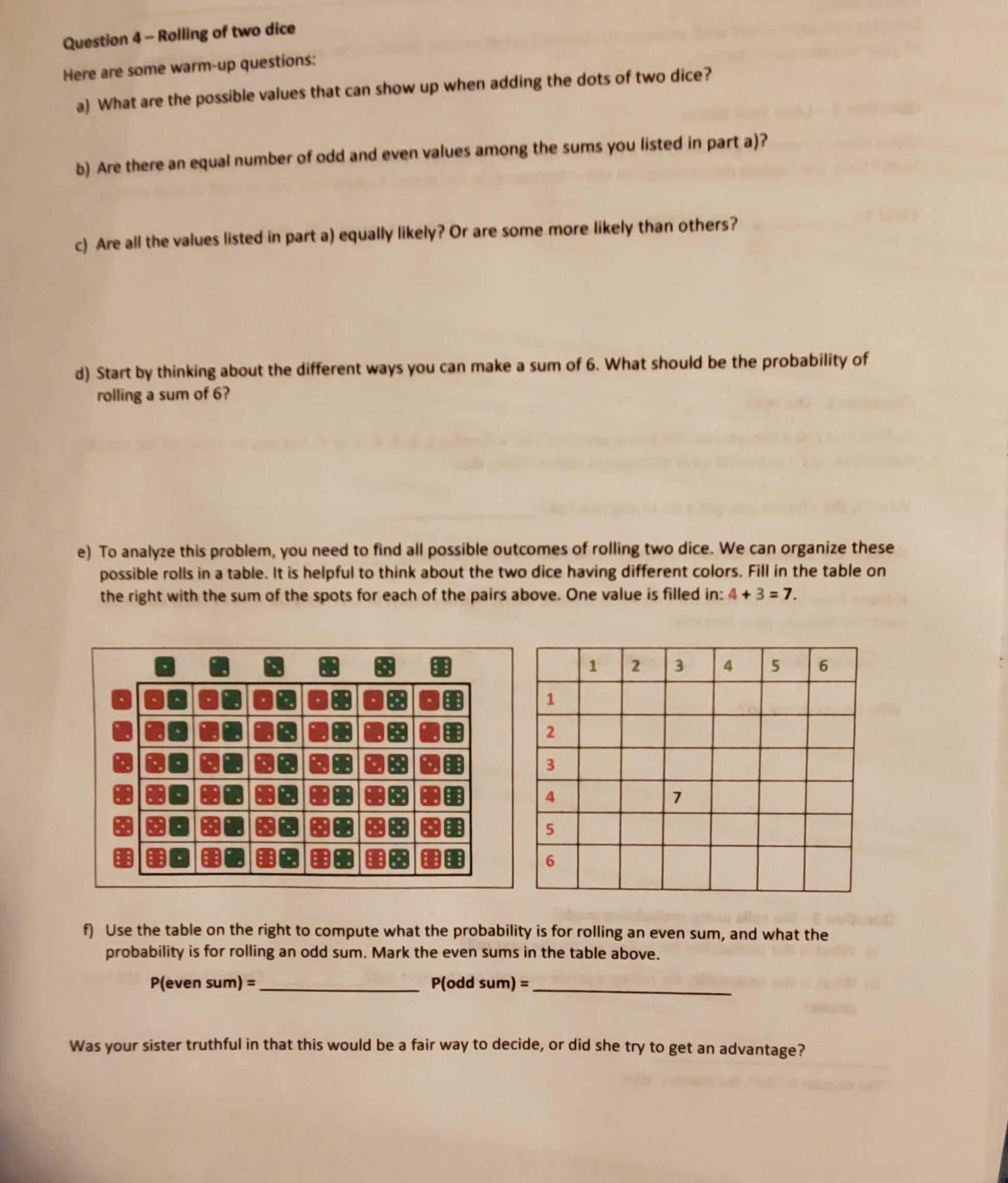Question 4-Rolling of two dice Here are some warm-up questions: a) What are the possible values that can show up when adding the dots of two dice? b) Are there an equal number of odd and even values among the sums you listed in part a)? c) Are all the values listed in part a) equally likely? Or are some more likely than others? d) Start by thinking about the different ways you can make a sum of 6. What should be the probability of rolling a sum of 6? e) To analyze this problem, you need to find all possible outcomes of rolling two dice. We can organize these possible rolls in a table. It is helpful to think about the two dice having different colors. Fill in the table on the right with the sum of the spots for each of the pairs above. One value is filled in: 4 + 3 = 7. 1 5 6 1 4 7 C f) Use the table on the right to compute what the probability is for rolling an even sum, and what the probability is for rolling an odd sum. Mark the even sums in the table above. P(even sum) P(odd sum)= Was your sister truthful in that this would be a fair way to decide, or did she try to get an advantage?
Question 4-Rolling of two dice Here are some warm-up questions: a) What are the possible values that can show up when adding the dots of two dice? b) Are there an equal number of odd and even values among the sums you listed in part a)? c) Are all the values listed in part a) equally likely? Or are some more likely than others? d) Start by thinking about the different ways you can make a sum of 6. What should be the probability of rolling a sum of 6? e) To analyze this problem, you need to find all possible outcomes of rolling two dice. We can organize these possible rolls in a table. It is helpful to think about the two dice having different colors. Fill in the table on the right with the sum of the spots for each of the pairs above. One value is filled in: 4 + 3 = 7. 1 5 6 1 4 7 C f) Use the table on the right to compute what the probability is for rolling an even sum, and what the probability is for rolling an odd sum. Mark the even sums in the table above. P(even sum) P(odd sum)= Was your sister truthful in that this would be a fair way to decide, or did she try to get an advantage?
Chapter8: Sequences, Series,and Probability
Section8.7: Probability
Problem 6ECP: In Pennsylvania’s Cash 5 game, a player chooses five different numbers from 1 to 43. If these five...
Related questions
Question

Transcribed Image Text:Question 4-Rolling of two dice
Here are some warm-up questions:
a) What are the possible values that can show up when adding the dots of two dice?
b) Are there an equal number of odd and even values among the sums you listed in part a)?
c) Are all the values listed in part a) equally likely? Or are some more likely than others?
d) Start by thinking about the different ways you can make a sum of 6. What should be the probability of
rolling a sum of 6?
e) To analyze this problem, you need to find all possible outcomes of rolling two dice. We can organize these
possible rolls in a table. It is helpful to think about the two dice having different colors. Fill in the table on
the right with the sum of the spots for each of the pairs above. One value is filled in: 4 + 3 = 7.
1
5
6
1
4
7
C
f) Use the table on the right to compute what the probability is for rolling an even sum, and what the
probability is for rolling an odd sum. Mark the even sums in the table above.
P(even sum)
P(odd sum)=
Was your sister truthful in that this would be a fair way to decide, or did she try to get an
advantage?
Expert Solution
This question has been solved!
Explore an expertly crafted, step-by-step solution for a thorough understanding of key concepts.
This is a popular solution!
Trending now
This is a popular solution!
Step by step
Solved in 4 steps with 1 images

Recommended textbooks for you

